Armed Forces of the Republic of Uzbekistan
The Armed Forces of the Republic of Uzbekistan (Uzbek: Oʻzbekiston Respublikasi Qurolli Kuchlari), is the name of the unified armed forces of Uzbekistan, consisting of a Ground force, Air and Air Defense forces, National guard [2] a Frontier service.[3] and a Navy. It is reported to be the largest, and the strongest in Central Asia.[4]
| Armed Forces of the Republic of Uzbekistan | |
|---|---|
| Oʻzbekiston Respublikasi Qurolli Kuchlari | |
.svg.png.webp) Standard of the Armed Forces (Cyrillic) | |
.svg.png.webp) Standard of the Armed Forces (Latin) | |
| Founded | 14 January 1992 |
| Service branches | Uzbek Ground Forces Uzbek Air and Air Defence Forces Uzbek Naval Forces |
| Headquarters | Tashkent, Uzbekistan |
| Leadership | |
| President of Uzbekistan | |
| Minister of Defense | |
| Chief of the General Staff | |
| Manpower | |
| Conscription | 18 years of age for compulsory military service; conscript service obligation - 12 months |
| Available for military service | 6,340,220 males, age 18-49 (2005 est.), 6,432,072 females, age 18-49 (2005 est.) |
| Fit for military service | 4,609,621 males, age 18-49 (2005 est.), 5,383,233 females, age 18-49 (2005 est.) |
| Reaching military age annually | 324,722 males (2005 est.), 317,062 females (2005 est.) |
| Active personnel | 48,000 (2018)[1] 20,000 paramilitary (2018)[1] |
| Expenditures | |
| Percent of GDP | 2% (2005 est.) Another reported figure is 3.7% |
| Industry | |
| Foreign suppliers | |
| Related articles | |
| Ranks | Rank insignia |
Uzbekistan and Russia signed a mutual defence pact in 2005, that will also result in closer military cooperation. This marked a stark contrast to a few years earlier, when the US appeared to be Uzbekistan's favoured foreign friend, and relations with Russia were cooler.[5]
'The country [has] also began professionalizing its military, an effort that has only limited success and erratic government support. But even in Uzbekistan, these changes represent merely a modest beginning and most of the benefits are concentrated in a few elite, higher readiness formations rather than uniformly applied to the entire force. The Uzbek military is woefully inadequate, but it is far superior to its neighbours.'[6] Uzbekistani military, by far, is alongside Kazakhstan, are both wealthy and quickly developed arms.
The government maintains a command and staff college for the military in Tashkent, based on the former Soviet TVOKU higher command college.
History
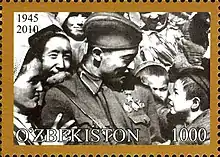
Tashkent, the capital of Uzbekistan, used to be the headquarters of the Soviet Turkestan Military District and on 20 February 1992, the new Ministry of Defence took over the offices which had been formerly occupied by the district headquarters staff.[7] The Uzbek SSR had the strongest Soviet military presence of the other Central Asian Republics, controlling its own and operating its own domestic Ministry of Internal Affairs (MVD) independent of the Ministry of Internal Affairs of the Soviet Union. On 2 July 1992 a Presidential Decree established a Ministry of Defence to supersede the Ministry of Defence Affairs. Over the succeeding years, Uzbekistan replaced Russian officers with ethnic Uzbeks and restructured the military to focus on targets like civil unrest, drug trafficking, and Hizb-ut-Tahrir. The three major Soviet military academies, the Tashkent Higher All-Arms Command School, the Chirchiq Higher Tank Command and Engineering School, and the Samarkand Higher Military Automobile Command School, were located in Uzbekistan. This caused the government to not send Uzbek officers to Russia for training. In 1994, they established the joint Armed Forces Academy, to train officers of all branches. Though the Uzbek language was becoming more in use by the army, Russian remained the main language used in training officers, due to the fact that most manuals were in Russian and that the Central Asian Turkic languages did not have proper military vocabulary.
Military reforms were implemented after the appointment of civilian Kadyr Gulyamov to the defence ministry. Soviet-style regimental structures, were replaced, with the basic fighting unit consisting of 14 soldiers. "Ranger" detachments based on the American model were also formed.[8]
Since Shavkat Mirziyoyev came to power, the military has been involved in re-arming its military with modern equipment.[9]
Activities and foreign relations
From August to September 1997, Uzbekistan took part in the exercises of the Central Asian Battalion (CENTRASBAT) in Kazakhstan and Uzbekistan. as part of an eight nation joint exercise which include the United States, Russia and Ukraine.[10][11][12] After the September 11, 2001 attacks, the United States leased the Karshi-Khanabad airbase in southern Uzbekistan, which borders Afghanistan. The American base there was called "Camp Stronghold Freedom," yet was more often referred to as "K2 Airbase" by the personnel in theater.
In May 2005, the military was involved in suppressing unrest in the Ferghana Valley city of Andijan, which became known as the Andijan massacre. Consequently, the EU banned arms sales and imposed a one-year visa ban on 12 senior officials, including the security chief and interior and defence ministers, accusing them of bearing responsibility for the killings.[13]
In the aftermath of the incident, President Karimov dismissed several senior military figures: Defense Minister Gulyamov, Head of the Joint Headquarters of the Armed Forces Ismail Ergashev, and Commander of the Eastern Military District Kosimali Akhmedov. Burnashev and Chernykh said that '..although these dismissals did not change the formal system of administration in the security and military structures, they reflected serious shifts in power relations among regional elites representing their clans.'[14]
A joint statement of the member countries of the Shanghai Co-operation Organisation issued in early July 2005 on a conference in the Kazakh capital of Astana (now Nur-Sultan) called for a withdrawal of US troops from military bases in Central Asia. On July 29, 2005, Uzbekistan invoked a provision asking the U.S. to leave within 180 days. On November 21, 2005, the withdrawal of US troops from Karshi-Khanabad and any other bases was completed.[15]
The European Union lifted the arms sales ban in 2009.

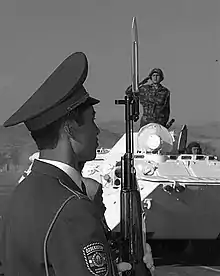
Arms control and non-proliferation
The government has accepted the arms control obligations of the former Soviet Union, and acceded to the Nuclear Non-Proliferation Treaty as a non-nuclear state. It has also supported an active program by the U.S. Department of Defense Defense Threat Reduction Agency in western Uzbekistan (Nukus and the biological warfare test laboratory on Vozrozhdeniye Island).
Land Forces
The army includes five military districts In 2001, the Tashkent garrison was transformed into the Tashkent Military District.[16] The headquarters of the military districts and their areas of responsibility are as follows:[17]
| District | Headquarters Location | Notes |
|---|---|---|
| Northwest Military District | HQ Nukus | Karakalpakstan, Xorazm Province |
| Southwest Special Military District | HQ Karshi | Qashqadaryo Province, Surxondaryo Province, Bukhara Province, Navoiy Province |
| Central Military District | HQ Dzhizak | Dzhizak Province, Samarqand Province, Sirdaryo Province |
| Eastern Military District (EMD) | Ferghana | Fergana Province, Andijan Province, Namangan Province |
| Tashkent Military District | HQ Tashkent | Tashkent Province, Established 2001 |
Current equipment
Reportedly, Uzbek armed forces small arms include the AK-47, AK-74, Dragunov sniper rifle, Makarov PM pistol, and PK.
Air Forces
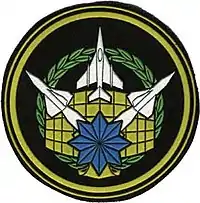
The Uzbek air forces consist of units formerly part of the 49th Air Army of the Turkestan Military District headquartered at Tashkent. There are two remaining combat units, brigades at Karshi-Khanabad and Dzhizak.[17]
The 60th Separate Brigade is the former 735th Bomber Aviation Regiment combined with the former 87th Separate Reconnaissance Aviation Regiment.[23] It has 31 Su-24s, 32 MiG-29s, and 6 Su-27s. Other recently disbanded units include the 61st Fighter Aviation Regiment at Kakaydy, which was itself a merger with the previous 115th Fighter Aviation Regiment, and the 62nd Fighter Aviation Regiment at Andijan. Regiments at both bases were disbanded in 1999. As many as 26 stored Su-17s, apparently in very bad condition, remain at Chirchiq (see Google Earth 41°30'05.69"N 69°33'44.90"E).
List of units
- 60th Separate Mixed Aviation Brigade (Karshi-Khanabad)(60 BAP), Su-24/Su-24MR, Su-27- (31 Su-24, 32 MiG-29, 6 Su-27, 1200 personnel.)
- Separate Mixed Aviation Brigade, Dzhizak, Su-25 - (Su-25, L-39, Mi-8, Mi-24)
- Separate Mixed Aviation Regiment, Fergana, Аn-12, 12РР, 26, 26РР
- Separate Mixed Aviation Squadron, Tashkent, Аn-24, Тu-134
- 65th Separate Helicopter Regiment Kagan, Bukhara Mi-6,8. According to the IISS Military Balance 2002- 28 Mi-6, 29 Mi-8. Former 396th Separate Helicopter Regiment, Southern Group of Forces
- 66th Separate Helicopter Regiment, Chirchiq, Mi-8/24/26 helicopters. The IISS Military Balance 2002 listed Uzbekistan with 42 Mi-24, 29 Mi-8,1 Mi-26
- 12th Anti-Aircraft Rocket Brigade
- Radio-Technical Brigade


Current air force equipment
| Aircraft | Origin | Type | In service | Notes |
|---|---|---|---|---|
| Sukhoi Su-27 | Multi role fighter | 25 | ||
| Sukhoi Su-24 | Long-range bomber | 32 | Stored | |
| Mikoyan MiG-29 | Multi role fighter | 60[24] | ||
| Sukhoi Su-17 | Ground attack | 38 | Stored | |
| Sukhoi Su-25 | Ground attack | 25 | Active | |
| Aero L-39 Albatros | Light attack/ trainer | 14 | ||
| Ilyushin Il-76 | Heavy transport | 6 | ||
| An-12 | Medium transport | 5 | ||
| An-24 | Medium transport | 1 | ||
| An-26 | Medium transport | 15 | ||
| Boeing 767-300 | VIP Transport | 1 | UK-67000, governmental plane | |
| Mi-8 Hip/Mi-17 Hip | Medium transport helicopter | 64 | ||
| Mil Mi-6 | Heavy transport helicopter | 27 | ||
| Mil Mi-26 | Heavy transport helicopter | 1 | ||
Paramilitary and militarized forces
The following institutions are uniformed and have military affiliations but are not part of the Armed Forces:
- National Security Service (SNB), the country's secret police
- Frontier Service (also called the Committee for State Border Protection of the National Security Service), the border guard of Uzbekistan. They have gotten into disagreements with the Kyrgyz Frontier Force in the Batken Region.[25] The Frontier Service also operates the riverine naval assets of Uzbekistan, which include two Gyurza class gunboats.[26]
- Internal Troops, they are commonly used against Islamic terrorists in the border regions near Tajikistan and Kyrgyzstan. It maintains several Spetsnaz battalions:[27]
- Scorpion Group
- Bars
- Ts
- Alpha Group
- Uzbekistan National Guard also serves as a specialized elite force.
Military education

- Under the Defence Ministry[28][29]
- Combined Arms
- Ground forces
- Chirchiq Higher Tank Command and Engineering School
- Samarkand Higher Military Automobile Command School
- Jizzakh Higher Military Technological University
- Air Force
- Under Paramilitary services
- Higher Military Customs Institute
- Academy of the Ministry of Internal Affairs of Uzbekistan
- Military-Technical Institute of the National Guard of Uzbekistan
- Institute of Civil Defense of the Ministry of Emergency Affairs
In addition to the schools mentioned, the Tashkent Medical Academy maintains its own Military Medical Faculty.[30] Four military lyceums (high schools) in Tashkent, Samarkand, Fergana, and Urgench, all of which were established in 1993, are run by the military for pre-military education. In January 2001, Sergeant Training Schools were established in Tashkent, Central, South-West and Eastern military districts.[31] Officers of the military, national police, special forces, and Ministry of Internal Affairs attend courses at the Joint Service Officer Training Academy in the capital.[32]
Military culture
Military oath

The Military oath (Uzbek: Harbiy qasamyod) is taken by conscripts as a legal basis of the beginning of their military service. The oath is administered by the commanding officer of the unit while a colour guard lowers the national flag for the soldier to kiss after he/she has taken the oath. The first military oath of the Armed Forces of Uzbekistan was adopted at the 10th session of the 12th convocation of the Supreme Soviet of Uzbekistan on 3 July 1992. The following is the text for the 1992 version of the oath:[33]
"I, (last name, first name, fatherland), joining the ranks of the Armed Forces of the Republic of Uzbekistan, solemnly swear allegiance to its people and the President.
I swear piously to abide by the Constitution and the laws of the Republic of Uzbekistan, to unconditionally fulfill military regulations, orders of commanders and chiefs, to strictly observe military discipline, to be honest, brave and watchful warrior.
I swear before the memory of my ancestors to be the true son of my homeland until the last breath, to withstand all the burdens and deprivations of military service, to keep state and military secrets.
I swear in the name of the bright future of my native Uzbekistan to be a worthy advocate of its state interests and independence. If I break this solemn oath, then let me be overtaken by the harsh punishment of the laws and the contempt of the people!"
With the entry of the Law "On General Military Commitment and Military Service" adopted by the Supreme Assembly in 2002, the oath was abolished and the original text was made unavailable. In April 2018, a long proposed new version of the oath was approved. The new version is as follows:[34]
"When I am in the ranks of the Armed Forces of the Republic of Uzbekistan, I swear to honor the Republic of Uzbekistan, to be loyal to my people and to the President.
I swear to honor and adhere to the Constitution and the laws of the Republic of Uzbekistan, to obey the orders of the military commanders and officers placed before me, to strictly adhere to military discipline and to be an honest, brave and vigilant serviceman.
Until the last breath, I swear in the spirit of my ancestors to be a faithful child of my Homeland, to steadfastly endure all the hardships and difficulties of the military service and to maintain the secrets of the state and the military secrets of the armed forces.
For the bright future of my dear Uzbekistan, I swear to be a worthy defender of state interests and independence.
If I ever break this solemn oath, I would be subject to the most severest punishments prescribed by law and the hatred of my people!"
Holidays
These are the military holidays observed by all service personnel the Uzbek Armed Forces:
- 14 January – Defender of the Motherland Day
- 15 February – International Duties Memorial Day
- 5 April – National Security Service Day
- 9 May – Day of Remembrance and Honour
- 3rd day in August – Uzbek Air Force Day[35]
- 25 October – Police and Internal Affairs Servicemen's Day
Cultural institutions
The armed forces maintains a number of cultural institutions that operated under the Ministry of Defense. Those institutions include the following:[36]
- State Museum of the Armed Forces of Uzbekistan – Founded in 1965 as the Museum of the Turkestan Military District, the State Museum of the Armed Forces (Uzbek: Oʻzbekiston Respublikasi Qurolli Kuchlari markaziy muzeyi) is under the direct control of the Ministry of Defense, being located in the ministry's central building since May 1975. The museum exhibits over 10,000 pieces of memorabilia, including Second World War era tanks and military artifacts from the Timurid dynasty.[37][38]
- Tashkent House of Military Officers – The main building was built in 1885 and was used as a military assembly by the Imperial Russian Army before the October Revolution of 1917. In 1924, it housed the first House of the Red Army. In 1945, it became the House of Officers for the HQ Turkestan Military District. In the 1990s, after Uzbekistan gained its independence, it was renamed the Central House of Officers of the Ministry of Defense of Uzbekistan.[39] Since 2013, the original building of the Central House of Officers has been occupied by the Tashkent State Institute of Law.[40]
- Center for Spirituality and Enlightenment of the Ministry of Defense
- Central Song and Dance Ensemble of the Armed Forces
- Band of the Ministry of Defense
- Band of the Ministry of the Interior
- Band of the National Guard
Citations
- IISS 2019, p. 217.
- John Pike. "Uzbekistan- Army". Archived from the original on 19 October 2014. Retrieved 23 October 2014.
- "The World Factbook". Retrieved 23 October 2014.
- "Today.Az » Politics » Uzbekistan would prefer to be policeman of Central Asia: expert". Archived from the original on 7 November 2014. Retrieved 23 October 2014.
- BBC, Archived 2005-11-30 at the Wayback Machine
- McDermott, JSMS, 2002, p.30
- Richard Woff, 'Independence and the Uzbek Armed Forces,' Jane's Intelligence Review, December 1993, p.567
- "Civilian Takes Charges Of Uzbek Army". Institute for War and Peace Reporting. Retrieved 2020-12-21.
- "Uzbek armed forces renew nearly half of weapons in past four years - Xinhua | English.news.cn". www.xinhuanet.com. Retrieved 2021-01-16.
- "Archived copy". Archived from the original on 2018-07-10. Retrieved 2018-07-10.CS1 maint: archived copy as title (link)
- "Archived copy". Archived from the original on 2018-07-10. Retrieved 2018-07-10.CS1 maint: archived copy as title (link)
- "Archived copy". Archived from the original on 2018-07-10. Retrieved 2018-07-10.CS1 maint: archived copy as title (link)
- "BBC". BBC News. Archived from the original on 17 May 2009. Retrieved 23 October 2014.
- Rustam Burnashev and Irina Chernykh, Changes in Uzbekistan's Military Policy After the Andijan Events Archived 2009-03-26 at the Wayback Machine, China and Eurasia Forum Quarterly, Volume 5, No. 1 (2007), Central Asia-Caucasus Institute & Silk Road Studies Program, ISSN 1653-4212, p. 72
- US Completes Withdrawal From Uzbek Base
- Bakhtiyar Kamilov, Formation of Conceptual Approaches to the Problems of Ensuring National Security in Central Asian States - Uzbekistan, Kazakhstan, Kyrgyzstan, Tajikistan and Turkmenistan Archived 2009-03-26 at the Wayback Machine
- "Archived copy". Archived from the original on 2007-10-18. Retrieved 2007-09-29.CS1 maint: archived copy as title (link), accessed late September 2007 and June 2010
- [↑ The International Institute For Strategic Studies IISS The Military Balance 2010. — Nuffield Press, 2010. — С. 373. — ISBN 978-1-85743-557-3.]
- Archived 2016-06-14 at the Wayback Machine the-military-balance-2016 —
- Пентагон завершит поставки Узбекистану бронетехники в ближайшее время Archived 2015-07-19 at the Wayback Machine — 12news.uz, 15.06.2015
- Archived 2016-01-16 at the Wayback Machine thediplomat.com
- ""Future Artillery Systems: 2016 Market Report"" (PDF). Archived (PDF) from the original on 2018-01-22.
- For 735th Bomber Aviation Regiment, see Michael Holm, Archived 2012-03-18 at the Wayback Machine, and for 87th Separate Reconnaissance Aviation Regiment, see Archived 2012-03-18 at the Wayback Machine
- "World Military Aircraft Inventory". 2011 Aerospace: Aviation Week and Space Technology, January 2011.
- "Uzbekistan's Frontier Service: Kyrgyzstan aggravates situation in Sokh enclave". Trend. 10 August 2011. Archived from the original on 29 October 2013. Retrieved 23 October 2014.
- "Archived copy". Archived from the original on 2017-03-07. Retrieved 2017-03-06.CS1 maint: archived copy as title (link)
- "Archived copy". Archived from the original on 2013-08-18. Retrieved 2013-10-04.CS1 maint: archived copy as title (link)
- https://kun.uz/36762707
- https://mg.uz/print/publish/doc/text62868_ya_b_v_voennye_poshel_vysshee_voennoe_obrazovanie_v_uzbekistane
- "Archived copy". Archived from the original on 2019-03-06. Retrieved 2019-03-05.CS1 maint: archived copy as title (link)
- http://mudofaa.uz/kr/qurolli-kuchlar-tarixi/uzbekiston-armiyasining-solnomasi/33752/
- https://sldinfo.com/2012/11/uzbekistans-military-reform-and-partner-potential/
- http://www.lex.uz/docs/-86952?otherlang=1
- http://darakchi.uz/oz/48961
- http://lex.uz/ru/docs/120147
- http://mg.uz/publish/doc/text98554_centralnyy_dom_oficerov_pereehal_v_novoe_zdanie_v_tashkente
- https://www.afisha.uz/catalog/7761/
- https://orexca.com/rus/tashkent_museum_armed_forces.shtml
- https://www.afisha.uz/gorod/2013/09/03/odo-razobrali-dokirpichey/
- http://wikimapia.org/520250/ru/%D0%91%D1%8B%D0%B2%D1%88%D0%B8%D0%B9-%D0%B4%D0%BE%D0%BC-%D0%BE%D1%84%D0%B8%D1%86%D0%B5%D1%80%D0%BE%D0%B2
References
- IISS (2019). The Military Balance 2019. Routledge. ISBN 978-1857439885.
Further reading
- Roger N. McDermott, The armed forces of the republic of Uzbekistan 1992-2002: Threats, influences and reform, The Journal of Slavic Military Studies, Volume 16, Issue 2 June 2003, pages 27 – 50
External links
| Wikimedia Commons has media related to Military of Uzbekistan. |


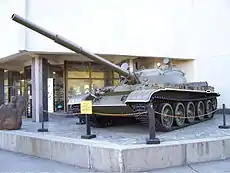
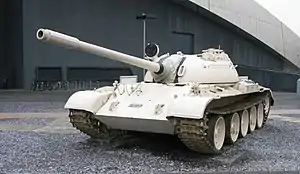
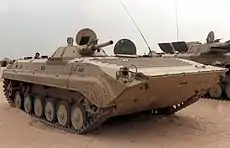
.jpg.webp)



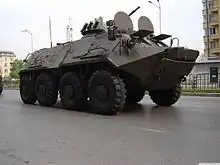
_(262-6).jpg.webp)
.jpg.webp)

.jpg.webp)
_owned_by_James_Stewart_pic5.JPG.webp)





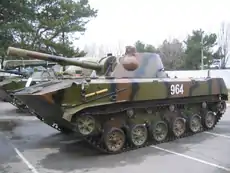
.jpg.webp)


.jpg.webp)